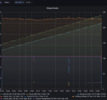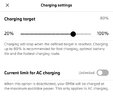Are you getting similar voltage readings with the Tesla on both chargers?
Also, what if you dial down the charging not all the way to 16 A, but try dialing down amp by amp in the app or car charging current limit and see when the gates come back to life.
Volt drop within the installation (in cable from house to garage and from garage to gate) seems most likely and the 'gut feeling' of many. A double whammy of volt drop when you are charging on the garage charger and operating the gate. Then you have Vdrop in the cable from house to garage with charging current plus gate motor inrush current, and further Vdrop in the garage to gate cable with just motor inrush current.
But if that's the cause then we'd expect it to be OK when charging with your new charger that is not on the garage circuit. Because in that situation there is no more volt drop in the house-garage-gate circuit than when the car is not charging at all.
The alternative, and only thing that as making much sense to me, is that this is primarily external voltage drop in the supply. That's why I asked if you are on a TT installation. If the external supply cable is oddly long and undersized then a large current draw on any circuit could drop your voltage at the origin due to Vdrop in the supply cable. Then add to that Vdrop in the cable to the gate under inrush current. This would help to explain why it happens on both chargers.
But then that doesn't really explain why the BMW doesn't cause it! But maybe it draws just a little bit less and that makes the difference - that's why I ask you to try the Tesla at 31, 30, 29, etc limit. But external Vdrop also seems unlikely since you are on a 100 A supply fuse and you measure a healthy 230 V at the car when charging.
So I'm as stumped as ever. Maybe the focus should be on the gate. Would be interesting to know the length and csa of the house to garage cable, and the csa of the 40 m gate cable. Also how old is the motor? Maybe an old or failing motor plus mechanical gate mechanism not in good shape is causing epic inrush current and combined total Vdrop then enough to stop the controller. But then why with only the Tesla!!
You do need to get a spark to investigate the gate circuit more than Tesla to look at the car, imho. Maybe a new motor with soft start controller and a lube of all the mechanicals will sort this. Good luck, most interesting thread on here, would watch the movie!





